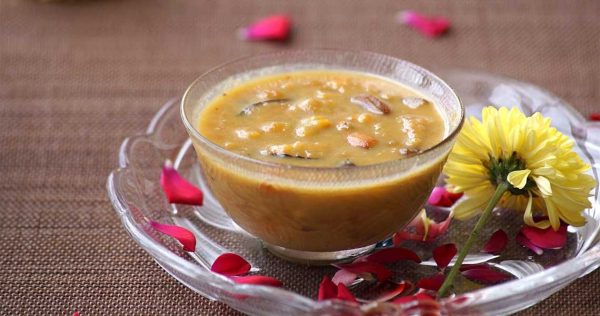Ugadi Festival Recipes
Pesara Pappu Payasam
Pesara Pappu or Pasi Paruppu Payasam With the advent of the month of Shravan (sometime in July-August according to the Gregorian calendar) begins the festival season in India and my mind is full of ideas of how to celebrate the plethora of festivals and poojas that await us. In our home, the first major Pooja of the season is Varalakshmi Pooja.
Celebrated on the Friday that precedes the full-moon in the month of Sravan (Shravana Pournami Poorvaasta Shukravaare or simply the Friday before Raksha Bandha or Nariyal Poornima) by married women across Andhra Pradesh, Karnataka, and some parts of Tamil Nadu, Varalakshmi Pooja is said to bestow prosperity and well-being on the family.
Sri Lakshmi is the Goddess of Prosperity and manifests in many forms. As Varalakshmi (Vara = boon), she grants her devotees their wishes. Legend has it that Varalakshmi appeared in the dreams of a lady called Charumati and asked her to perform Varalakshmi Vratam. Charumati performed the Vratam along with other ladies from the village and as soon as the Pooja was over, they ladies found themselves blessed with riches.
The pooja involves offerings of clothes, jewellery, flowers, leaves, and assorted types of

| Passive Time | 45 minutes |
| Servings |
MetricUS Imperial
|
|

|
- Dry roast the pesara pappu till it starts to change colour.
- Add 1 cup milk and 1/2 cup water.
- Pressure cook for 4 to 6 whistles, or till the pesara pappu is of mashable consistency. Use a large vessel so that there is a lot of empty space after adding the pappu, milk, and water because milk has a tendency to boil over.
- Using a heavy ladle, mash the dal.
- Peel the green cardamom and crush the seeds to a coarse powder. It is easier to crush cardamom seeds if you add about 1 tsp of sugar. The volume makes it easier to crush the seeds.
- Add the remaining milk, cardamom, and sugar to the cooked pesara pappu.
- Mix well.
- Over medium heat, bring the payasam to a gentle simmer.
- Heat the ghee.
- Break the cashew in halves and add to the ghee.
- Stir-fry the cashew till it starts to change colour.
- Add the raisins and stir-fry till the raisins start to puff up.
- Add the fried cashew and raisins to the payasam.
- Mix well.
- Serve warm.
I find that cooking the pesara pappu in milk gives the payasam a richer taste. You could also cook it using just water.
food to the goddess. The naivedyam at my home typically includes at least two sweet dishes; one “dry” sweet such as Poornam Boorelu, Bobbatlu or Chandrakantalu as well as a payasam such as Semiya Payasam, Pal Payasam, or Paravannam.
Here is another payasam that is popular with us; Pesara Pappu Payasam, which is known Pasi Paruppu Payasam in Tamil Nadu and Kerala. In this version, I have used sugar as it is faster to make this payasam this way. I will write about the recipe that uses jaggery or bellam in a later post.








